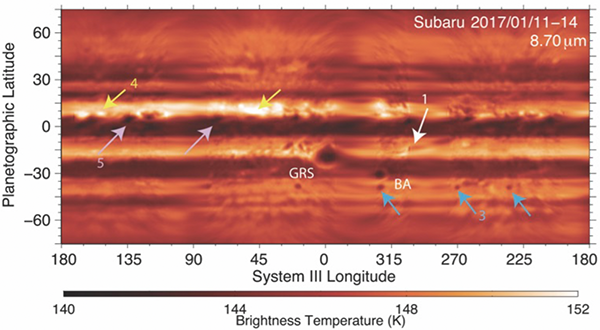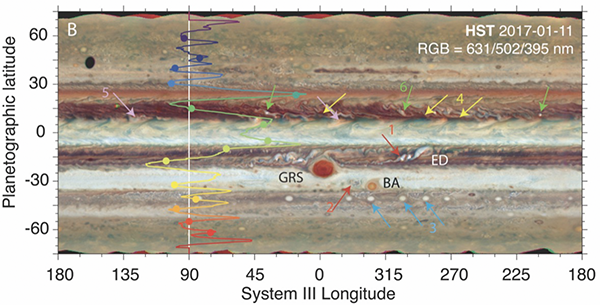NEWS
The worldwide multi-wavelength observation campaign of Jupiter has discovered that storms are disturbing the planets colorful belts.
Multi-wavelength measurements from telescopes worldwide have captured the eruption of storms in Jupiter's northern and southern equatorial belts.
The discovery was made as part of a coordinated, worldwide observation campaign of Jupiter that took place in January 2017. The campaign utilized telescopes across the globe to track the storms. These included: the Atacama Large Millimeter/Submillimeter Array (ALMA, Chile), the Very Large Array (VLA: Arizona, USA), NASA's Hubble Space Telescope (HST), the Gemini North Telescope (Hawaii), the Very Large Telescope (VLT, Chile), and the W. M. Keck Telescope (Hawaii) Tohoku's contribution came via the National Astronomical Observatory of Japan's (NAJO) Subaru Telescope.
The tracked storms were visible as bright plumes above the planet's main ammonia ice cloud deck. The rising plumes then interacted with Jupiter's powerful winds, which stretched the clouds far from their points of origin.
The multi-wavelength observations were consistent with one theory, known as moist convection, in explaining the plumes' formation. According to this theory, upwelling winds carry a mix of ammonia and water vapor high enough for the water to condense into liquid droplets. The condensed water releases heat that expands the cloud and buoys it quickly upward through other cloud layers, ultimately breaking through the ammonia ice clouds at the top of the atmosphere.
"Mid-infrared images of Jupiter from the Subaru Telescope, the Very Large Telescope and the ALMA radio observations indicate that the plumes are dark at wavelengths where the ammonia gas absorbs," said Glenn Orton of Caltech's Jet Propulsion Laboratory in the United States. "This demonstrates the plumes are rich in ammonia gas, which supports the theory they are driven by moist convection."
Yasumasa Kasaba of Tohoku University added. "This is a great example of using coordinated observations over several wavelength regimes to improve the understanding of atmospheric phenomena on other planets."
Tohoku University operates its own radio and visible-infrared telescopes around Sendai and in Haleakala, located on Hawaii's Maui Island. It also works with the Hisaki ultraviolet space telescope operated by the Japan Aerospace Exploration Agency (JAXA), as a part of this international Jupiter observation campaign. These Subaru observation results are linked to those activities.
The observations will ultimately help planetary scientists understand the complex atmospheric dynamics on Jupiter, which, with its Great Red Spot and colorful bands, make it one of the most beautiful and changeable giant gas planets in the solar system.
These results are described in a paper led by Dr. Imke de Pater of UC Berkeley (USA) that has been published by the Astronomical Journal online. Glenn Orton, James Sinclair of Caltech's Jet Propulsion Laboratory (USA) and Yasumasa Kasaba of Tohoku University provided the Subaru mid-infrared images using the COMICS instrument.
image:
 Subaru/COMICS map of Jupiter at 8.70 microns. Images recorded over the four consecutive nights (January 11-14, 2017) were stitched together to produce an image over 360 degrees in longitude. Several features are indicated on the map (Great Red Spot (GRS), Oval BA (BA), Source SEB Outbreak by arrow #1, Vortices by arrow #3, Hot Spots by arrow #4, and Large Plumes by arrow #5).
Subaru/COMICS map of Jupiter at 8.70 microns. Images recorded over the four consecutive nights (January 11-14, 2017) were stitched together to produce an image over 360 degrees in longitude. Several features are indicated on the map (Great Red Spot (GRS), Oval BA (BA), Source SEB Outbreak by arrow #1, Vortices by arrow #3, Hot Spots by arrow #4, and Large Plumes by arrow #5).
Copyright: Imke de Pater et al.

HST map at optical wavelengths from 11 January, 2017, with the zonal wind profile superimposed.
Copyright: Imke de Pater et al.
Links:
National Astronomical Observatory Japan (NAOJ)・press release:
https://subarutelescope.org/Pressrelease/2019/08/23/
UC Berkeley press release:
https://news.berkeley.edu/2019/08/22/storms-on-jupiter-are-disturbing-the-planets-colorful-belts/
https://news.berkeley.edu/2016/06/02/new-radio-map-of-jupiter-reveals-whats-beneath-colorful-clouds/
National Radio Astronomy Observatories (USA) News release:
https://public.nrao.edu/news/image-release-alma-shows-whats-inside-jupiters-storms/
Publication Details:
Title: First ALMA Millimeter Wavelength Maps of Jupiter, with a Multi-Wavelength Study of Convection
Convection: https://arxiv.org/abs/1907.11820
Authors: Imke de Pater, R. J. Sault, Chris Moeckel, Arielle Moullet, Michael H. Wong, Charles Goullaud, David DeBoer, Bryan Butler, Gordon Bjoraker, Mate Adamkovics, Richard Cosentino, Padraig T. Donnelly, Leigh N. Fletcher, Yasumasa Kasaba, Glenn Orton, John Rogers, James Sinclair, Eric Villard
Journal: Astronomical Journal
Embargo date: 2019/08/23
Contact:
Yasumasa Kasaba
Planetary Plasma and Atmospheric Research Center,
Graduate School of Science, Tohoku University
Email: kasaba * pparc.gp.tohoku.ac.jp
(Replace * with @)




